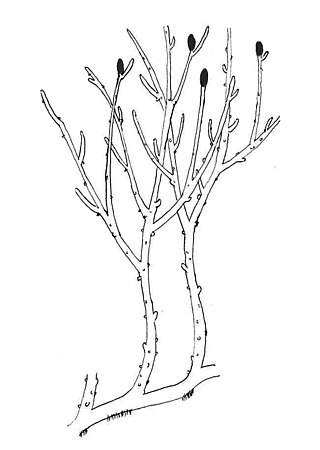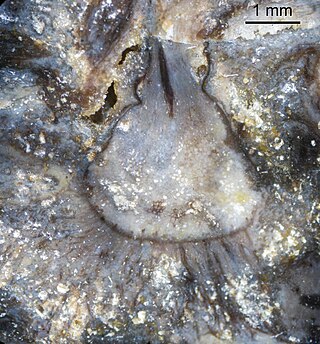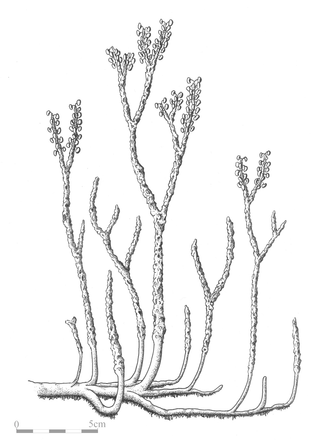Related Research Articles

Lycopodiopsida is a class of vascular plants known as lycopods, lycophytes or other terms including the component lyco-. Members of the class are also called clubmosses, firmosses, spikemosses and quillworts. They have dichotomously branching stems bearing simple leaves called microphylls and reproduce by means of spores borne in sporangia on the sides of the stems at the bases of the leaves. Although living species are small, during the Carboniferous, extinct tree-like forms formed huge forests that dominated the landscape and contributed to coal deposits.

The lycophytes, when broadly circumscribed, are a vascular plant (tracheophyte) subgroup of the kingdom Plantae. They are sometimes placed in a division Lycopodiophyta or Lycophyta or in a subdivision Lycopodiophytina. They are one of the oldest lineages of extant (living) vascular plants; the group contains extinct plants that have been dated from the Silurian. Lycophytes were some of the dominating plant species of the Carboniferous period, and included tree-like species, although extant lycophytes are relatively small plants.

The zosterophylls are a group of extinct land plants that first appeared in the Silurian period. The taxon was first established by Banks in 1968 as the subdivision Zosterophyllophytina; they have since also been treated as the division Zosterophyllophyta or Zosterophyta and the class or plesion Zosterophyllopsida or Zosteropsida. They were among the first vascular plants in the fossil record, and had a world-wide distribution. They were probably stem-group lycophytes, forming a sister group to the ancestors of the living lycophytes. By the late Silurian a diverse assemblage of species existed, examples of which have been found fossilised in what is now Bathurst Island in Arctic Canada.

Asteroxylon is an extinct genus of vascular plants of the Division Lycopodiophyta known from anatomically preserved specimens described from the famous Early Devonian Rhynie chert and Windyfield chert in Aberdeenshire, Scotland. Asteroxylon is considered a basal member of the Lycopsida.

Drepanophycales is an order of extinct lycopsid plants of Late Silurian to Late Devonian age, found in North America, China, Russia, Europe, and Australia. Sometimes known as the Asteroxylales or Baragwanathiales.

The rhyniophytes are a group of extinct early vascular plants that are considered to be similar to the genus Rhynia, found in the Early Devonian. Sources vary in the name and rank used for this group, some treating it as the class Rhyniopsida, others as the subdivision Rhyniophytina or the division Rhyniophyta. The first definition of the group, under the name Rhyniophytina, was by Banks, since when there have been many redefinitions, including by Banks himself. "As a result, the Rhyniophytina have slowly dissolved into a heterogeneous collection of plants ... the group contains only one species on which all authors agree: the type species Rhynia gwynne-vaughanii". When defined very broadly, the group consists of plants with dichotomously branched, naked aerial axes ("stems") with terminal spore-bearing structures (sporangia). The rhyniophytes are considered to be stem group tracheophytes.
Crenaticaulis was an early genus of slender, dichotomously branching, leafless land plants, known from the Devonian period and first described in 1969. They were probably allied to the zosterophylls, and are assigned to subdivision Zosterophyllophytina, or class Zosterophyllopsida. They bore branches and scalariform tracheids.

Trimerophytopsida is a class of early vascular plants from the Devonian, informally called trimerophytes. It contains genera such as Psilophyton. This group is probably paraphyletic, and is believed to be the ancestral group from which both the ferns and seed plants evolved. Different authors have treated the group at different taxonomic ranks using the names Trimerophyta, Trimerophytophyta, Trimerophytina, Trimerophytophytina and Trimerophytales.

Polysporangiophytes, also called polysporangiates or formally Polysporangiophyta, are plants in which the spore-bearing generation (sporophyte) has branching stems (axes) that bear sporangia. The name literally means 'many sporangia plant'. The clade includes all land plants (embryophytes) except for the bryophytes whose sporophytes are normally unbranched, even if a few exceptional cases occur. While the definition is independent of the presence of vascular tissue, all living polysporangiophytes also have vascular tissue, i.e., are vascular plants or tracheophytes. Extinct polysporangiophytes are known that have no vascular tissue and so are not tracheophytes.

Aglaophyton major was the sporophyte generation of a diplohaplontic, pre-vascular, axial, free-sporing land plant of the Lower Devonian. It had anatomical features intermediate between those of the bryophytes and vascular plants or tracheophytes.

Rhynia is a single-species genus of Devonian vascular plants. Rhynia gwynne-vaughanii was the sporophyte generation of a vascular, axial, free-sporing diplohaplontic embryophytic land plant of the Early Devonian that had anatomical features more advanced than those of the bryophytes. Rhynia gwynne-vaughanii was a member of a sister group to all other eutracheophytes, including modern vascular plants.

Horneophyton is an extinct early plant which may form a "missing link" between the hornworts and the Rhyniopsida. It is a member of the class Horneophytopsida. Horneophyton is among the most abundant fossil organisms found in the Rhynie chert, a Devonian Lagerstätte in Aberdeenshire, UK. A single species, Horneophyton lignieri, is known. Its probable female gametophyte is the form taxon Langiophyton mackiei.

The Horneophytopsida, informally called horneophytes, are a class of extinct plants which consisted of branched stems without leaves, true roots or vascular tissue, found from the Late Silurian to the Early Devonian. They are the simplest known polysporangiophytes, i.e. plants with sporophytes bearing many spore-forming organs (sporangia) on branched stems. They were formerly classified among the rhyniophytes, but it was later found that some of the original members of the group had simple vascular tissue and others did not. The group has also been treated as the division Horneophyta.

Yunia is a genus of extinct vascular plants from the Early Devonian. It was first described from the Posongchong Formation of Yunnan, China. The leafless plant consisted of spiny stems, some 2 to 5 cm wide, which branched dichotomously at wide angles in a cruciate arrangement. Each stem contained vascular tissue with one or two strands of protoxylem. The spore-forming organs (sporangia) were elongated and borne on short stalks. The spores had a relatively smooth sculptural pattern and were trilete.
Hicklingia is a genus of extinct plants of the Middle Devonian. Compressed specimens were first described in 1923 from the Old Red Sandstone of Scotland. Initially the genus was placed in the "rhyniophytes", but this group is defined as having terminal sporangia, and later work showed that the sporangia of Hicklingia were lateral rather than strictly terminal, so that it is now regarded as having affinities with the zosterophylls.
Huia is a genus of extinct vascular plants of the Early Devonian. The genus was first described in 1985 based on fossil specimens from the Posongchong Formation, Wenshan district, Yunnan, China.

Nothia was a genus of Early Devonian vascular plants whose fossils were found in the Rhynie chert in Scotland. It had branching horizontal underground stems (rhizomes) and leafless aerial stems (axes) bearing lateral and terminal spore-forming organs (sporangia). Its aerial stems were covered with small 'bumps' (emergences), each bearing a stoma. It is one of the best described early land plants. Its classification remains uncertain, although it has been treated as a zosterophyll. There is one species, Nothia aphylla.
Protobarinophyton was a genus of Silu-Devonian land plant with branching axes. It is placed in a group of early vascular plants (tracheophytes), the barinophytes, a group that has been given various ranks and scientific names.

Ventarura is a genus of extinct vascular plants of the Early Devonian. Fossils were found in the Windyfield chert, Rhynie, Scotland. Some features, such as bivalved sporangia borne laterally and the anatomy of the xylem, relate this genus to the zosterophylls. Other features are unclear due to poor preservation.
The barinophytes are a group of extinct vascular plants (tracheophytes). Their relationship with other vascular plants is unclear. They have been treated as the separate class Barinophytopsida, the order Barinophytales of uncertain class and as a family or clade Barinophytaceae within the zosterophylls. They have also been considered to be possible lycopodiopsids.
References
- 1 2 Crane, P.R.; Herendeen, P. & Friis, E.M. (2004), "Fossils and plant phylogeny", American Journal of Botany, 91 (10): 1683–99, doi: 10.3732/ajb.91.10.1683 , PMID 21652317
- ↑ Taylor, T.N.; Taylor, E.L. & Krings, M. (2009), Paleobotany : The Biology and Evolution of Fossil Plants (2nd ed.), Amsterdam; Boston: Academic Press, ISBN 978-0-12-373972-8 , p. 226
- ↑ Smith, A.R.; Pryer, K.M.; Schuettpelz, E.; Korall, P.; Schneider, H.; Wolf, P.G. (2006), "A classification for extant ferns" (PDF), Taxon, 55 (3): 705–31, doi:10.2307/25065646, JSTOR 25065646 , retrieved 2011-01-28
- ↑ Kidston, R. & Lang, W.H. (1917), "On Old Red Sandstone plants showing structure, from the Rhynie Chert Bed, Aberdeenshire. Part I. Rhynia GwynneVaughani", Transactions of the Royal Society of Edinburgh, 51 (761–84), doi:10.1017/S0080456800008991 , cited in Crane, Herendeen & Friis 2004
- ↑ Sporne, K.R. (1966), The Morphology of Pteridophytes (2nd ed.), London: Hutchinson, ISBN 978-0-09-104881-5 , p. 28ff.
- 1 2 3 4 5 Kenrick, Paul & Crane, Peter R. (1997), The Origin and Early Diversification of Land Plants: A Cladistic Study, Washington, D.C.: Smithsonian Institution Press, ISBN 978-1-56098-730-7 , pp. 139–40, 249
- ↑ Stewart, W.N. & Rothwell, G.W. (1983), Paleobotany and the Evolution of Plants (2nd ed.), New York: Cambridge University Press, ISBN 978-0-521-23315-6 , quoted in Waggoner, Ben (1996), Introduction to the Zosterophylls, archived from the original on 2011-01-26
- ↑ Arens, N.C.; Strömberg, C. & Thompson, A. (1998), Lab VI The Origin of Seed Plants, archived from the original on 2010-12-03
- ↑ Gensel, P.G. (1992), "Phylogenetic relationships of the zosterophylls and lycopsids: evidence from morphology, paleoecology, and cladistic methods of inference" (PDF), Annals of the Missouri Botanical Garden, 79 (3): 450–73, doi:10.2307/2399750, JSTOR 2399750
- ↑ Taylor, Taylor & Krings 2009 , p. 227